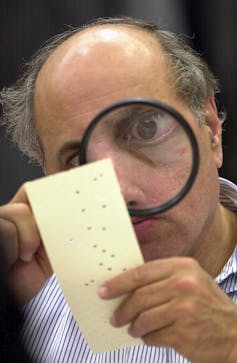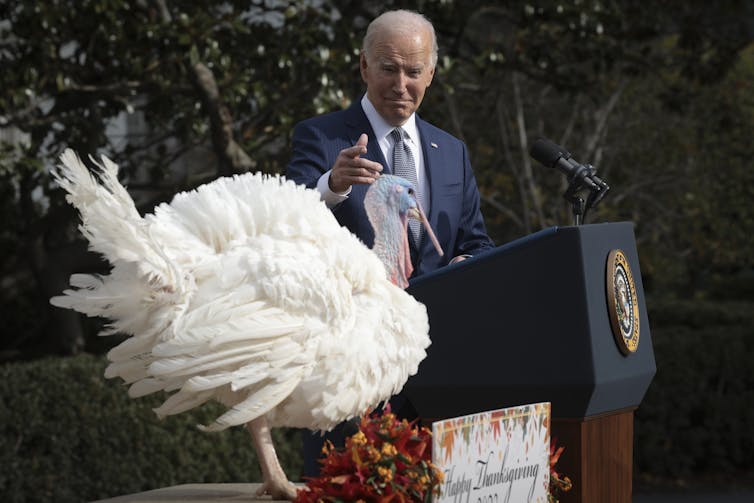The election is over − but what is a ‘lame duck’ anyway?
- Written by Jordan Cash, Assistant Professor of Political Theory and Constitutional Democracy, Michigan State University
 The term 'lame duck' has been around for hundreds of years, often referring to a person whose ability to exercise authority is limited for some reason.Planet Flem/DigitalVision Vectors via Getty Images
The term 'lame duck' has been around for hundreds of years, often referring to a person whose ability to exercise authority is limited for some reason.Planet Flem/DigitalVision Vectors via Getty ImagesThe 2024 election has finally ended. What happens now?
There’s a 2½-month period between Election Day and Inauguration Day. It’s commonly known as the “lame-duck” period, when the outgoing president still holds official power but their successor has been chosen and is waiting to take the reins. Donald Trump is constitutionally barred from a third term in office by the 22nd Amendment, so he will be a lame duck from his first day in office, though his successor will not be known until 2028.
But during the lame-duck transitional period, like the one in which Joe Biden now finds himself, the outgoing president typically works with his successor to ensure the peaceful transfer of power. The president-elect looks to fill the thousands of positions that will staff their new administration, which sometimes involves working with the Senate to vet Cabinet nominees in advance of official votes on their appointments.
The lame-duck period in the U.S. is longer than in other Western democracies, which tend to make the transition over a period of just days. For instance, when the U.K. Labour Party won parliamentary elections on July 4, 2024, the party’s leader, Keir Starmer, was installed as prime minister and was moving into the official residence at 10 Downing St. within a day.
One explanation for this difference is structural. In parliamentary systems, the opposition party has what is called a “shadow cabinet,” counterparts to the majority party’s official cabinet that can assume power quickly if their party wins an election.
In the U.S., by contrast, the new president must build an administration from the ground up, appointing approximately 4,000 administration positions, including the heads of 15 executive departments making up the cabinet and 10 other cabinet-level officials. Even a president-elect from the same party as the incumbent will want to bring in their own staff and allies.
A vestige of 18th-century travel
There are historical reasons for the long lame-duck period in the U.S., as presidential historian Lindsay Chervinsky has pointed out.
Constitutional rules allowing states to set their own election days, as well as more limited communication and travel technology in the 18th and 19th centuries, meant that for most of the nation’s history it has taken a significant amount of time for election results to become clear, and even longer for victorious candidates to travel to the nation’s capital.
In fact, the original day a new president’s term was to start was March 4 – though travel delays meant George Washington wasn’t able to be inaugurated until April 30, 1789, after being elected on Jan. 7, 1789. Inauguration Day changed in 1933 with the ratification of the 20th Amendment, which started congressional sessions on Jan. 3 and presidencies on Jan. 20.
An opportunity to resolve disputes
The long delay between the election and inauguration provides time to investigate and resolve any questions or concerns about the election.
In 1876, for instance, when Republican Rutherford B. Hayes was running against Democrat Samuel Tilden, state officials in Florida, Louisiana and South Carolina submitted conflicting slates of electors for the Electoral College. One of Oregon’s electors was also challenged as ineligible.
To adjudicate the dispute, Congress – divided between a Democratic House and Republican Senate – created a unique electoral commission made up of members of the House, Senate and the Supreme Court. After working for over a month, the commission awarded all the disputed electoral votes to Hayes on March 2, 1877, two days before Inauguration Day.
 An examiner looks at a disputed election ballot in Florida during a recount in the 2000 presidential election.AP Photo/Alan Diaz
An examiner looks at a disputed election ballot in Florida during a recount in the 2000 presidential election.AP Photo/Alan DiazSimilarly, in the 2000 election between Republican George W. Bush and Democrat Al Gore, confusion over ballots in Florida led to calls by Democrats for a recount. The result was dueling lawsuits in the Florida Supreme Court and the U.S. Supreme Court. On Dec. 12, 2000, the U.S. Supreme Court ruled in Bush v. Gore that the recount had to be stopped because the various Florida counties were not following uniform standards. By law, Florida’s electors had to meet on Dec. 18, so there was not enough time to institute uniform standards and complete a full recount. Bush was ahead when the recount ceased, so he won Florida and, by extension, the presidency.
An opportunity for uncertainty
Long lame-duck periods can also be a source of danger. In the period between Abraham Lincoln’s election in November 1860 and his inauguration in March 1861, seven southern states seceded from the Union. Incumbent President James Buchanan proved unwilling to take a strong stand against the secessionists, allowing the crisis to grow until Lincoln took office and ultimately resulting in the Civil War.
In 1932, Franklin D. Roosevelt was elected while the nation was in the throes of the Great Depression. Yet Roosevelt, like Lincoln, could not take action for five months – until he took office in March 1933 – leaving the country adrift in uncertainty during an extraordinary economic crisis.
An opportunity for farewell gifts
Conversely, lame-duck presidents may be able to take advantage of the relative lack of accountability provided by the fact that they will soon be leaving office. The most famous example of this was John Adams.
After Adams and his Federalist Party allies lost the presidency and Congress to Thomas Jefferson and his Democratic-Republicans in the election of 1800, they packed the federal courts. Adams and the Federalists appointed and confirmed Federalist John Marshall to be chief justice, reduced the number of justices on the Supreme Court from six to five to deny Jefferson a future Supreme Court appointment and created 16 new federal judgeships, which they filled with Federalists.
These actions infuriated the Jeffersonians. While they undid some of these changes – namely, adding back the seat the Federalists had removed from the Supreme Court and abolishing some of the federal judgeships – they could not undo them all.
 Presidents’ clemency power means they can pardon humans as well as Thanksgiving turkeys.Win McNamee/Getty Images
Presidents’ clemency power means they can pardon humans as well as Thanksgiving turkeys.Win McNamee/Getty ImagesAdams’ actions were a particularly egregious example of what a motivated lame-duck president can do, with the help of a willing lame-duck Congress. But it remains common for lame-duck presidents to aggressively employ their clemency powers.
Bill Clinton issued 140 pardons and 36 commutations on his last day in office, including a controversial pardon for billionaire Marc Rich, who had been convicted of tax fraud and had fled the country. Notably, Rich’s ex-wife, Denise Rich, was a major donor to the Democratic Party. Donald Trump similarly pardoned 74 people and commuted 70 other sentences on the last day of his first term in office, including his former political strategist Steve Bannon, who had been indicted for wire fraud and money laundering.
Although it is unlikely that the current divided Congress will help with much of anything before the new Congress takes office in January, it wouldn’t be surprising if Joe Biden takes some unpopular and unexpected actions before passing power to his successor.
Jordan Cash does not work for, consult, own shares in or receive funding from any company or organization that would benefit from this article, and has disclosed no relevant affiliations beyond their academic appointment.
Authors: Jordan Cash, Assistant Professor of Political Theory and Constitutional Democracy, Michigan State University
Read more https://theconversation.com/the-election-is-over-but-what-is-a-lame-duck-anyway-242377

